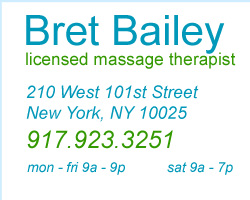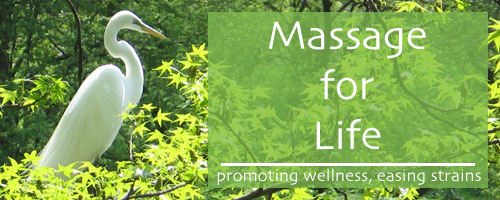Self Care Between Massages
Relieving and Preventing Springtime Neck Strain
by Bret Bailey, LMT
Tip #5 - March, 2010
Now that Winter's behind us and Spring has finally arrived, if you're like me, you probably can't wait to leave that heavy jacket and scarf behind and enjoy the unencumbered freedom of the season. Well, this is exactly why this article is appearing now.
As you know, Spring is a season of rebirth and renewal, transitioning us from Winter to Summer. And during this transition, with its often significant temperature fluctuations, we're likely to leave the house less protected from the elements than usual. From a Chinese perspective, this carries its own set of consequences, but from our Western perspective, it can mean we suddenly find ourselves in weather colder than we anticipated, and ultimately compensating for those extra layers that are still hanging in our hall closet, by tensing our muscles and drawing our bodies in tightly. We may be folding our arms across our torsos, curling up our fingers, stuffing them into our pockets, or most importantly, at least for this piece, raising our shoulders up to protect our necks. All, of course, leading to tension. Now, add this to usual habit of holding stress in our shoulders and necks, and you may find yourself in need of a good massage therapist.
If this is sounds like you, a nice simple way to relieve upper neck tension between massages, and one that you can do for yourself, requires little more that a few well-placed fingers, and some wind points.
What are wind points?
Well, getting back to that Eastern perspective, wind points are specific areas on the body that are particularly susceptible to invasion from outside elements, or "external pernicious factors"- EPF's for short. Cold, and of course, wind, are high on the list of the EPF's that can enter the body through these wind points, often resulting in numerous forms of dis-ease including the common cold and flu. And while there are other wind points on the body, for now, we're going to focus on the ones on your neck. You may feel them as tender spots at the base of your skull, all aptly named- "Wind Screen," "Wind Pool," and "Wind Mansion".
In Western vernacular, these points correspond to the often over-taxed muscles at the base of the skull. together these points, extending pretty much from ear to ear, and where the back of your head meets your neck, comprise a line that's crossed by numerous muscles, including trapezius, the erectors (splenius capitus, semispinalis capitus, longisimus capitus), suboccipitals, levator scapula, and sternocleidomastoid (scm). Now in the Spring, when we shrug those shoulders, these muscles become tightened and strained, leading to neck discomfort and even headaches.
Fortunately, these muscles and points, are among the many on your body that respond well to self massage. In fact, most of these muscles can be massaged almost anywhere. On the train, at your desk, at the movies, even while sitting at a table in a restaurant while your blind date slips off to powder her nose.
To begin, take the pinky of your right hand and bring the tip of it gently behind your right ear. Where the neck meets the ear, you'll find a soft divot (TE 17 - Wind Screen), into which the tip of your finger can rest comfortably. While gently keeping your pinky in this spot, bring your other fingers up to the base of our scull- where soft muscle meets firm bone. Don't worry if your fingers only reach halfway across this line of points, you have another hand for the other side.
Now that your fingers are placed, feel for tender areas along the line. When you find one, gently press the tip of our finger into it, and while maintaining contact, move your finger in small circles, basically applying a very specific circular friction to the points of focus. This slight friction will increase circulation to the area and release any adhesions or stickiness in the muscles.
Once you have the idea, and know where these points are, you can let your pinky join the other fingers as you work your way all along the line, addressing any tender points with the same circular friction.
One easy exercise you can do is to "work the line." Starting just behind that pinky divot you found earlier, take the tip of your index fingers- one on each side of your head, and every quarter of an inch or so, while moving your fingers toward the mid-line, press and apply that circular friction. Work all the way around the back of the head, and then work your way back toward your ears, and then back toward the center one more time.
After you've made three complete passes along these points, take your opened right hand and place it on the back of your neck, thumb pointing down, with the base of your fingers (that part where the four fingers meet your palm) resting against the spine of your neck, just below your hairline, and above your shoulders. Maintaining contact with your neck, gently squeeze the muscles on either side of your spine, almost as if you were trying to pick up a young puppy by the scruff of the neck. Hold this "squeeze" for about 5 seconds, and then while still squeezing, raise your shoulders towards your ears. Hold for another 5 seconds, then lower your shoulders and continue to squeeze for another 5 seconds. You can do this 2 or 3 times, and then switch over to your left hand, and repeat.
Follow up with gentle neck stretches (please bear in mind the weight of the average head- it's basically like a bowling ball perched up on your shoulders, so please go easy here). Start my leaning your head forward, letting the weight of it gently do the work, and hold for 30 seconds. Follow this with a gentile neck extension stretch, leaning your head all the way back, and then with some lateral flexion, bringing each ear towards its corresponding shoulder. Another great neck stretch is to look to one side, and then gently bring you still-rotated head towards your opposite shoulder. Again, please be sure to keep these stretches gentle, and hold for 30 seconds.
Thanks for joining me this month, and I hope this tip will bring you some relief between massages. Until next month, be well, and remember those scarves.
Warmly,
Bret Bailey, LMT
Please feel free to contact me with any comments, questions, or suggestions- just click here. |



